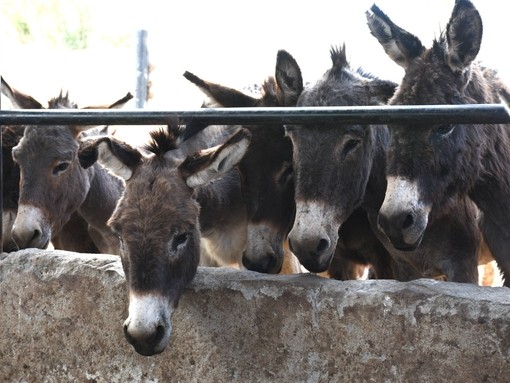
Do not change or delete this
An estimated 1,500 donkeys are slaughtered every day in Kenya’s four main donkey slaughterhouses; or 390,000 in 2017-2018.
As skins are considered the only valuable product of slaughter the dumping of body spare parts is causing local, environmental damage on a huge scale.
In 2017, Goldox slaughterhouse in Baringo, Kenya was temporarily closed due to its inadequate waste management procedures.
Visiting the area a month prior to closure, staff from The Donkey Sanctuary found a site claiming to be a breeding centre but was actually a massive disposal facility where unwanted body parts were dumped in huge pits daily.
Local farmer, Evans Kiprop, claimed his cows had become sick from pollution generated at the site and were now producing a quarter of the usual milk yield. Feral dogs and vultures were dragging donkey remains to an area where children played.
In a separate visit to the Naivasha and Kithyoko abattoirs in 2019, Janneke Merkx, Tactical Response Officer at The Donkey Sanctuary, described what she saw.
“There was a huge mountain of bones could not be missed, while crows, vultures and birds of prey circled above. The smell was inescapable; donkeys stood in line for slaughter next to gutters streaming with blood before being beaten with a stick and forced into the stunning box.“
Living in the shadow of Naivasha slaughterhouse, locals also tell a grim tale.
John Nduhiu, Chairman of The Donkey Owners Self Help Association has lost 12 donkeys and has organised several demonstrations against the Naivasha slaughterhouse.
He said: “This theft is destroying our chances of supporting our families; without their collateral, donkey owners slide into poverty, can’t feed their families, send their kids to school or access health care - the situation is critical for these people.”
Not only are the slaughter houses decimating Kenya’s local, national herd but theft and smuggling of donkeys from neighbouring countries for slaughter in Kenya is also damaging regional herds. Tanzania and Ethiopia in particular are feeling the impact of dwindling donkey populations.

Across the region, thousands of donkeys, many of them stolen, are rounded up to endure long journeys to slaughterhouses on crowded trucks without access food, water or rest with an estimated 20% of animals dying on route.
Another key knock-on effect for Kenyans and their neighbours is inflation in the cost of donkeys making it even harder for families who are already financially vulnerable to replace their animals once stolen.
Janneke added: “The sheer number of donkeys that are passing through the slaughterhouses is a concern, not just for animal welfare but also for the long-term sustainability of livelihoods that donkeys support.
“Populations seem to be dwindling quickly in Kenya, but if donkeys are coming from other countries, that is not just having an impact on Kenyan livelihoods but on the livelihoods of people in the entire region.
“Also, we are yet to see any evidence that the welfare of donkeys can be successfully ensured throughout the sourcing, the transport, the holding, the handling and the unsustainable losses of donkeys, which comes back to our message of calling for the trade to be halted until it can be proven to be sustainable and humane.”
Your support makes stories like this possible
Share this page
Tags
- News
